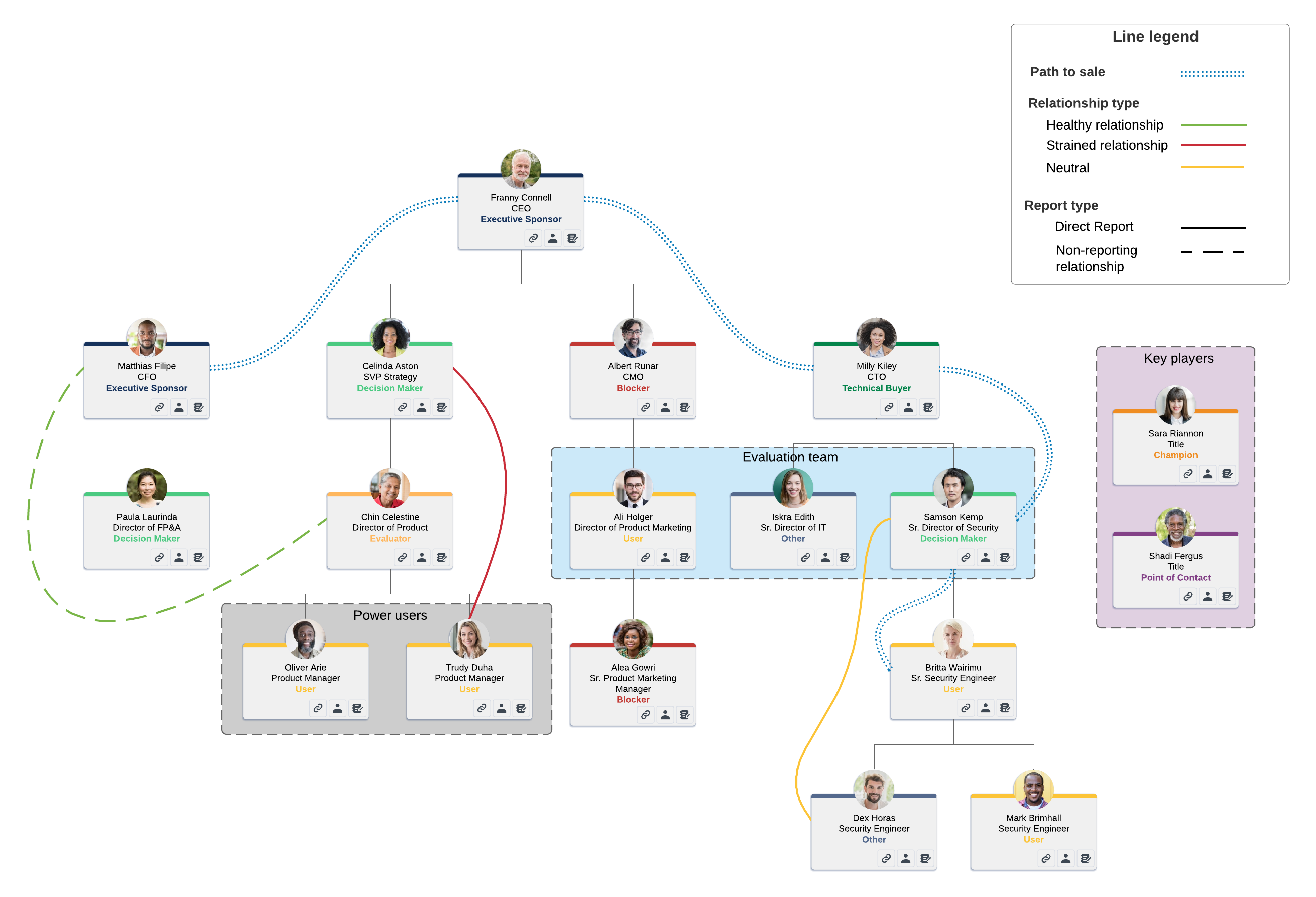Sales cycles and sales processes vary widely in complexity, duration, and value across companies and industries.
But one thing remains constant—the shorter the sales cycle, the better.
The faster you can close deals, the more time you have to close other deals or focus on other operations expansions. That's why it’s vital that you know how to identify the purchasing decision-makers of a given company in your outbound sales model.
On average, five decision-makers are involved in every sale. So you don’t have time to waste selling to the wrong people.
Below, we'll show you how to find the decision-makers in a company, shortening your sales cycle and saving you critical time and energy.
What is a decision-maker?
A decision-maker is a person who has the authority to make strategic and financial decisions for a team or organization. In sales, the decision-maker is the person (or people) you need to convince to buy.
Have you ever spent precious hours, days, or even weeks courting the wrong team member, only to find out the decision-maker you’re after is in a different office? Too often, salespeople waste valuable time pitching to a lead with little to no decision-making power, lengthening their sales cycle and risking redundancy.
By understanding who the decision-makers are in an organization, you can target your sales efforts to the right people who have the power to close a deal.
How to find decision-makers in a company
Use these tips to find decision-makers faster and drive sales.
1. Identify your sales leads
You’re unlikely to talk to a decision-maker on the first contact. Decision-makers are rarely directly accessible and are often barricaded and screened by caller ID, email filters, and assistants. But knowing who you’re talking to and their relationship to the decision-maker will save you valuable time and help you direct your conversations productively and identify who you need to get final buy-in from.
Here are the different types of leads you may connect with while trying to find decision-makers:
The gatekeeper
Typically, the gatekeeper is the lower-ranking point of contact between you and the decision-maker, like an assistant or associate. The goal of every sales conversation is to gain information while building a relationship—conversations with the gatekeeper should be no different.
Though you may be able to tell an associate’s proximity to a decision-maker by their title, building a relationship with someone at this level means asking clarifying questions like “In what capacity do you work with…? How would you describe your day-to-day priorities?”
Once the gatekeeper is identified, there are a couple of directions you can go. You can try going around the gatekeeper to reach the decision-maker directly (e.g., calling after hours when the gatekeeper has left the office, which can work for initial contact but is not always effective for a sustained sales process), or you may work with the gatekeeper and bring them along for the sale. They likely are aware of the decision-maker’s needs and pain points and can be a powerful ally in relaying the benefits of your product or service.
The influencer
The influencer is often a junior-level associate whose role is to screen problems and options before decision-makers sign off on them. Though they don’t have the final say, they have direct relationships with and influence over stakeholders.
While building a relationship with these individuals, you can gain insight into their power within the organization by asking questions like “Does Mr. or Mrs. X always listen to your recommendations?” or “Aside from yourself, who else will be involved in this decision?"
The answer to these questions will let you know how experienced the influencer is in offering solutions to the decision-maker and how involved you’ll need to be.
The champion
At the more proactive end of the influencer is the champion. A champion is an influencer who has shared information with you on the product/service review process, has given insight into how decisions are made and who makes them, or has introduced you to a key decision-maker.
Think of a champion as a coach or guide through the sales journey—while they may not directly make the sale for you, they are hands-on with lending you their unique knowledge and experience. Give these champions everything they need to connect you with the decision-maker. If they need to send an email, write it for them. If they need to persuade the decision-maker that your product or service is worth their time, provide them with collateral to share.
The self-proclaimed decision-maker
Avoid this person, as they are a toxic prospect. Look for warning signs like volunteering too much information on their salary or bragging about their proximity to the CEO. A self-proclaimed decision-maker can, however, still be a valuable influencer—it’s still good to build relationships but you’re asking questions like “How often do you meet with Mr. or Mrs. X?”, as strong influencers meet with decision-makers often.
The blocker
The blocker is also someone you want to avoid, as they can easily become a time vacuum. A blocker may come across as an influencer, both in their title and in their day-to-day role and responsibilities, making them a likely candidate to be a primary contact within the company.
However, a blocker will eventually stop returning phone calls, replying to emails, or engaging at all. A blocker may even intentionally thwart your sales efforts if, for example, they are an advocate for a legacy product or a champion for a competitor’s product or service. Blockers waste valuable time and resources—your follow-up, no matter how thorough and professional, will go unrequited, and either a new relationship will have to be formed or the lead may run cold.
Blockers will always exist, but there are ways to mitigate against the time they may cost you. Be actively engaged with your lead’s LinkedIn information. If a primary contact has become a blocker, pay attention to when your lead is hiring a new teammate and re-engage the sale through them.
What’s most important is to discern as early as possible if you’re speaking with a blocker. If you are, do your research and see if someone else at the company should hear what you have to offer.
2. Research your prospect's business
When identifying decision-makers within a company, avoid what most SDRs do and don’t base your hunt on job title alone. This approach may seem intuitive, but often the size and type of company will dictate where certain decisions will fall. For example, in smaller companies the CEO or a similar executive-level leader will be the primary decision-maker. But as an organization gets larger, department or team-level leaders may be the key decision-makers. So take time to research your prospect’s business up front.
Additionally, if your search is based on filtering out a single job title, you may miss valuable leads from companies that may not have the title or office you’re filtering for. You may end up finding the title you are looking for and build a great rapport with them, only to learn they don’t hold decision-making power.
3. Create decision-maker personas
Similar to buyer personas in the sales and marketing process, understanding who you’re looking for and how to pitch to them is done by developing decision-maker personas. To do this, find out as much as you can about your prospective decision-maker by asking questions like:
- What is this person’s title and responsibilities?
- What is this person’s tenure at this company?
- Who do they work with internally?
- How does this decision-maker interact with your company digitally?
- Are they a hands-on or hands-off decision-maker?
- Do they typically delegate research? If so, to who?
Similar to buyer personas in the sales and marketing process, understanding who you’re looking for and how to pitch to them is done by developing decision-maker personas. To do this, find out as much as you can about your prospective decision-maker according to the above questions. The more complete and developed your decision-maker persona, the better luck you’ll have reaching and building rapport with them.
4. Mapping the organization
Once you’ve completed all the steps above, you’re ready to begin mapping the company. Account mapping streamlines the sales process by allowing you to visualize the buying team so you can find the best path to sale. Using Lucidchart, you can import account, opportunity, contact, activity, and task data from Salesforce to easily build account maps and account plans.

Indicate each person’s role to easily identify who your influencers, decision-makers, gatekeepers, blockers, and champions are at the company and understand the relationships between them. When you share these visuals with your team, everyone can have a holistic view of the account at any given time, and account knowledge stays within the company.
As you continue to update your account map and make more connections, you will know who is the appropriate decision-maker to reach out to and how to initiate the next step of the sales process.
As with anything, with research, data, preparation, and action, closing deals can be more science than art. Knowing your decision-maker is a vital step in that process and can be done using these valuable tips and techniques.

Empower your sales team to see the path to win with Lucid.
Learn howAbout Lucidchart
Lucidchart, a cloud-based intelligent diagramming application, is a core component of Lucid Software's Visual Collaboration Suite. This intuitive, cloud-based solution empowers teams to collaborate in real-time to build flowcharts, mockups, UML diagrams, customer journey maps, and more. Lucidchart propels teams forward to build the future faster. Lucid is proud to serve top businesses around the world, including customers such as Google, GE, and NBC Universal, and 99% of the Fortune 500. Lucid partners with industry leaders, including Google, Atlassian, and Microsoft. Since its founding, Lucid has received numerous awards for its products, business, and workplace culture. For more information, visit lucidchart.com.
Related articles
How the 5-step sales process simplifies sales
Use a five-point sales process to take the guesswork out of sales. Learn about the 5-step sales process and how you can personalize your process with Lucidchart.
4 effective sales approaches to incorporate into your sales process
A sales approach is essentially a step-by-step proposition—developed to make the act of selling much more effective and reliable. Discover four different sales approaches you can immediately apply to any given selling situation.
12 templates for sales managers
In this post, we’ll discuss some Lucidchart templates you can use to make your life easier as you set up processes and track your sales team’s performance.
How to create a sales dashboard
With the help of a sales dashboard, you and your sales team can be better equipped to make important decisions and gain a high-level view of all the contributing KPIs that comprise your sales funnel. Learn how to create one now.

